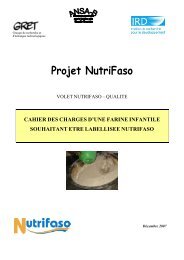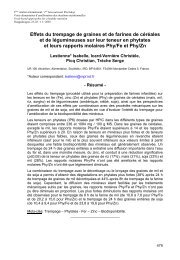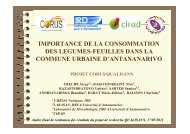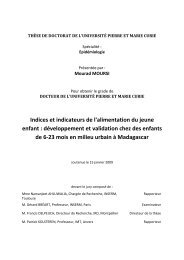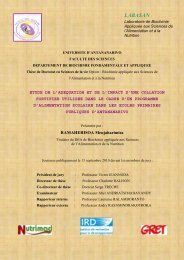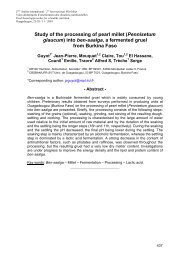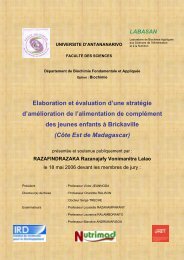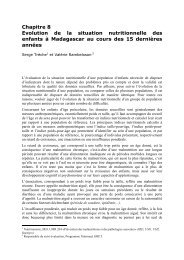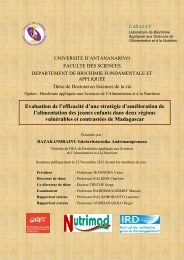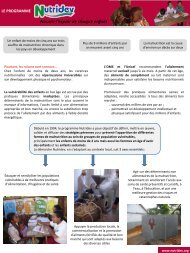THESE UNIQUE El Hassane Kéhien-Piho TOU - Nutridev
THESE UNIQUE El Hassane Kéhien-Piho TOU - Nutridev
THESE UNIQUE El Hassane Kéhien-Piho TOU - Nutridev
You also want an ePaper? Increase the reach of your titles
YUMPU automatically turns print PDFs into web optimized ePapers that Google loves.
E.H. Tou et al. / Food Chemistry 100 (2007) 935–943 941<br />
240<br />
140<br />
d<br />
Bostwick flow (mm/30s)<br />
200<br />
160<br />
120<br />
80<br />
40<br />
Ene<br />
rgy den<br />
sit y ( kc a l/ 100g<br />
of gru e l)<br />
120<br />
100<br />
80<br />
60<br />
40<br />
20<br />
a<br />
b<br />
c<br />
0<br />
of gruels with a Bostwick flow of 120 mm/30 s corresponding<br />
to a consistency suitable for infants and young children<br />
(Vieu et al., 2001), were deduced from the curves (Fig. 5).<br />
The DM contents of gruels prepared using the traditional<br />
processes (used as control), CI, CMI and CM process combinations<br />
were 6.5 ± 0.5, 12.4 ± 0.3, 17.5 ± 0.8 and<br />
27.6 ± 0.7 g DM/100 g, respectively. The addition of malt<br />
to gelatinized starch considerably modified the consistency<br />
of the gruels, and the highest DM content (27.6 g DM/<br />
100 g) was obtained with the CM process combination.<br />
Taking into account the addition of 3 g of sugar/100 g of<br />
gruel before consumption and an energy value of 4 kcal/g<br />
of DM, the ED of sweetened gruels corresponding to the<br />
control, CI, CMI and CM process combinations were<br />
39 ± 2.1, 62 ± 1.0, 81.3 ± 3.2 and 122 ± 2.6 kcal/100 g of<br />
gruel, respectively (Fig. 6). However, only the process combinations<br />
that included the addition of malt (CMI and<br />
CM) resulted in an ED close to or higher than the minimum<br />
value of 84 kcal/100 g of gruel recommended for children<br />
of 9–11 months of age at a rate of 2 meals/day added<br />
to average breast milk intake (Dewey & Brown, 2003).<br />
4. Discussion<br />
0 4 8 12 16 20 24 28 32 36 40<br />
Dry matter content (%)<br />
Control 1 CMI 1 CI 1 CM 1 CMI 2 Control 2<br />
CI 2 CM 2 Control 3 CMI 3 CI 3 CM 3<br />
Fig. 5. Effect of the different process combinations, traditional (control),<br />
cooking and addition of malt (CM), cooking and inoculation (CI) and<br />
cooking, addition of malt and inoculation (CMI) on gruel consistency.<br />
0<br />
Control CI CMI CM<br />
Fig. 6. Effect of the different process combinations, traditional (control),<br />
cooking and addition of malt (CM), cooking and inoculation (CI) and<br />
cooking, addition of malt and inoculation (CMI) on gruel energy density.<br />
Different letters indicate significantly different means (P < 0.05) as assessed<br />
by ANOVA and DuncanÕs multiple range test.<br />
The process combination involving cooking and the<br />
addition of malt (CM) considerably delayed the start of fermentation.<br />
This is explained by the marked reduction of<br />
the natural LAB population of the paste during cooking<br />
that have to be followed by reactivation of spoiled cells<br />
or by post-cooking contamination by LAB to promote fermentation.<br />
It suggests that the LAB contaminants, even if<br />
they develop at a low concentration during fermentation,<br />
are highly competitive compared to the other microorganisms.<br />
There was a slow decrease in pH after a period of<br />
time of about 8 h together with simultaneous production<br />
of lactic acid and ethanol. These conditions favour malt<br />
amylase activity (Trèche, 1999), leading to a high rate of<br />
starch hydrolysis and consequently to a significant<br />
(P



